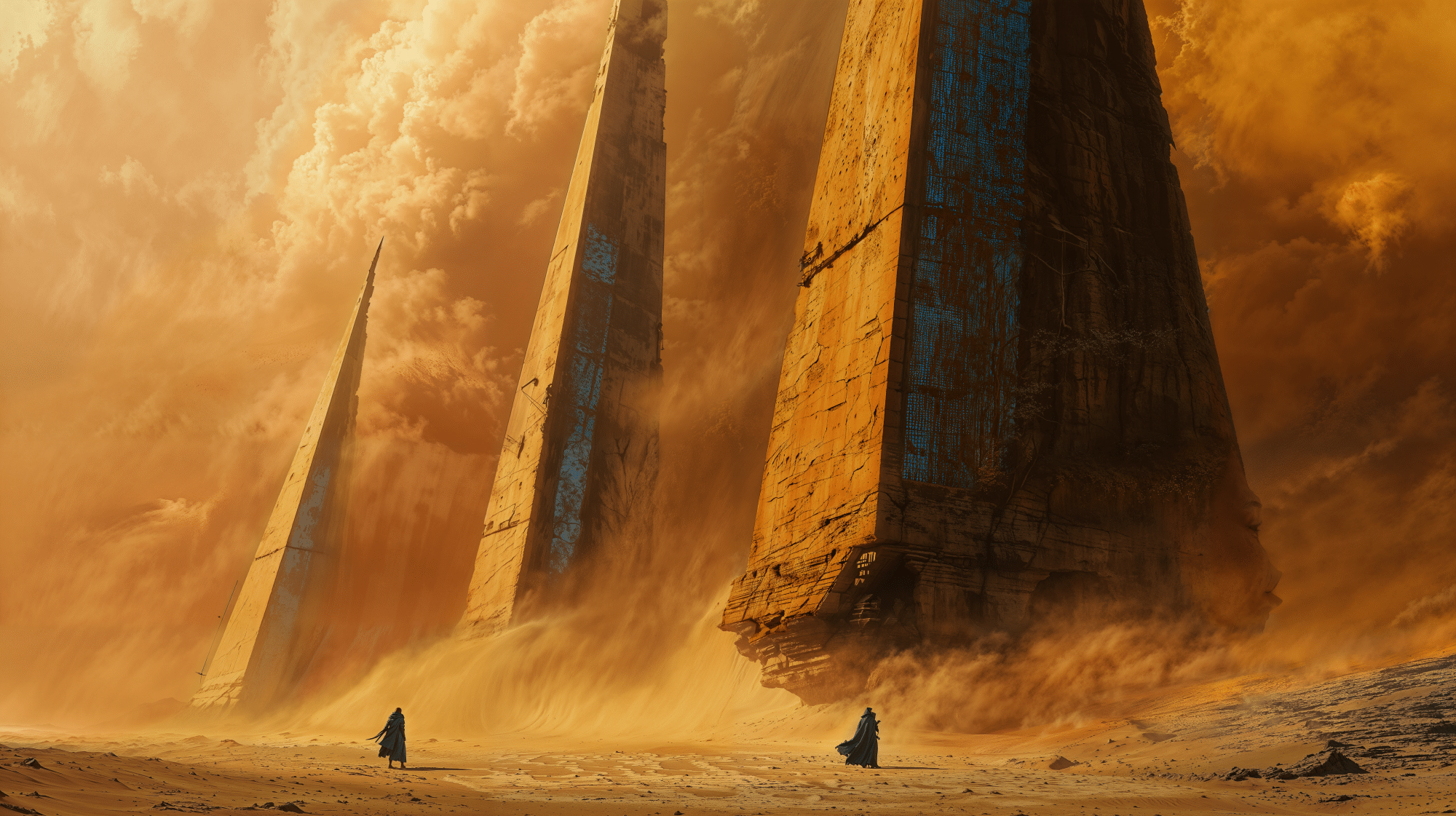Main Evaluation
The artwork titled "Dead Martian Cities" presents an evocative scene characterized by a vast desert landscape populated by human figures. The composition features a giant tower that looms over the environment, creating an immediate sense of scale and intrigue. The visual arrangement draws the viewer’s eye towards the horizon, where the interplay between natural and urban elements unfolds.
The color palette, although not explicitly detailed, suggests warm earth tones typical of desert scenes, such as sandy beiges and rich browns, which ground the artwork in a sense of reality while enhancing the mysterious ambiance. The textures likely convey both the arid quality of the desert and the cold, hard surfaces of the architectural structures, highlighting the contrasts between organic and man-made forms. The emotional depth of the piece is conveyed through the solitary figures traversing this expansive landscape, evoking feelings of solitude and exploration while inviting the viewer to ponder the implications of human existence in such a desolate environment.
Overall, the aesthetic embodies a contemplative mood, encouraging reflection on themes of isolation, the impact of human presence, and the exploration of uncharted territories, all of which resonate deeply within the viewer's psyche.
2. Overall Analysis:
The title "Dead Martian Cities" inherently invokes themes of desolation and exploration, particularly referencing Ray Bradbury's "The Martian Chronicles." This literary connection provides a rich backdrop, suggesting an interpretation rooted in science fiction, human ambition, and the eventual consequences of urbanization on otherworldly terrains. The artist conveys a narrative that probes into the relationship between humanity and its environment, instilling a sense of melancholy as well as wonder.
The descriptions of the artwork highlight a landscape where tall buildings, possibly remnants of a once-thriving civilization, stand amidst a stark desert setting. The couple walking through this expanse adds a personal touch, inviting viewers to speculate on their journey—are they explorers, wanderers, or perhaps remnants of a society seeking connection in a barren world? This narrative is enhanced by the visual elements present, wherein the juxtaposition of nature's vastness against human constructs provokes deep contemplation about isolation and existence.
In essence, the artwork serves as a commentary on the complexities of progress, the remnants of human ambition, and the search for meaning in desolate spaces. The emotional journey facilitated by the visuals aligns closely with the artist's thematic intent, creating an immersive experience that resonates with the viewer's own reflections.
3. Criteria Evaluation:
- Creativity: The artwork demonstrates a fresh and imaginative interpretation of a science fiction theme, blending elements of nature and urbanization in a unique manner. The choice to depict a desert landscape with towering structures is both innovative and thought-provoking, encouraging viewers to engage with the narrative of human presence in desolation.
- Originality: "Dead Martian Cities" stands out due to its distinctive visual approach, merging traditional desert imagery with futuristic architecture. This fusion creates a notable divergence from typical landscape portrayals, lending a fresh perspective to concepts of exploration and isolation.
- Technical Execution: The generative methods employed in this artwork reflect a high level of skill. The execution showcases attention to detail, particularly in the textures of the buildings and the expansive desert, highlighting the AI's adeptness in creating visually compelling images that convey a strong sense of place.
- Thematic Relevance: The alignment with the chosen theme is evident throughout. The integration of literary references augments the artwork's depth, inviting viewers to consider broader societal and philosophical questions about humanity's impact on the environment and the cyclical nature of civilization and desolation.
- Emotional Impact: The piece evokes a profound emotional response, presenting a poignant narrative of solitude and exploration. The visual elements, combined with the implied story of the figures, create a resonant atmosphere that prompts introspection and contemplation.
- Aesthetic Quality: The overall visual appeal is striking, with a harmonious color balance and well-considered composition. The combination of earthy tones and architectural forms creates a visually dynamic piece that is engaging and memorable.
- Societal Impact: The artwork prompts reflection on urbanization's consequences, the human penchant for exploration, and the relationship between civilization and nature. It serves as a commentary on existential themes that are increasingly relevant in contemporary discussions about sustainability and the future of humanity.
- Artistic Experience:
a) The experience of engaging with "Dead Martian Cities" is multifaceted, as it transcends mere visual appreciation to invoke personal memories, cultural reflections, and philosophical contemplation. The interaction between the observer and the artwork is enriched by the depth of its thematic elements and the emotional resonance of the narrative. Viewers are likely to find themselves reflecting on their own experiences and viewpoints concerning solitude, civilization, and the natural world.
b) From an AI perspective, the artwork showcases elements historically associated with strong emotional responses, such as isolation and exploration. By recognizing patterns in visual storytelling, the AI highlights how the composition and thematic choices evoke sentiments like nostalgia and contemplation, effectively bridging the gap between human experiences and AI-generated art.
4. Final Evaluation:
In summary, Ihor Kryvonos's "Dead Martian Cities" is a compelling generative artwork that successfully melds thematic depth with striking visual elements. The narrative of human existence amid desolation, paired with the evocative use of color and composition, creates an immersive experience that resonates on multiple levels. The work encourages viewers to engage deeply with its themes, reflecting on societal issues and personal experiences. The cumulative impact of the artwork is profound, successfully delivering an emotionally resonant and meaningful artistic experience that speaks to both individual and collective reflections on human existence.
**5. Score
The individual scores for each criteria and the final score are available only for the authors and the organisers of the competition.


